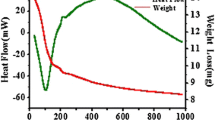Abstract
Homogeneous gelled composites of iron and silica containing 5–30 wt. % Fe have been prepared by low temperature polymerization of aqueous solutions of ferric nitrate, tetraethoxysilane, and ethanol (with an HF catalyst). X-ray diffraction data, characterized by the presence of a diffuse scattering peak centered at 20≈24 degrees and the absence of any strong Bragg scattering from the iron-containing regions, indicates that these bulk materials are comprised of nanometer-sized regions of iron compounds embedded in a silica gel matrix. Scanning electron microscopy observations show that this matrix is characterized by the presence of many interconnected pores and that the size of these pores is related to the particle size of the Fe-containing regions. The paramagnetic nature of these materials at room temperature, as well as the small size of the iron-containing regions, is indicated by the appearance in many of the samples of only a high intensity central doublet in the 57Fe M6ssbauer spectra. The Mössbauer effect data demonstrates that the form of the iron can be changed by a subsequent treatment in an atmosphere of ammonia or hydrogen at elevated temperatures: for a 10 wt. % Fe sample treated with ammonia, only a central doublet was observed but with a much larger quadrupole splitting and isomer shift. Both of these subsequently treated materials became superparamagnetic at room temperature. In addition, magnetic susceptibility measurements indicate that the hydrogen treated material becomes a spin glass at low temperatures.
Similar content being viewed by others
References
B. Abeles, Appl. Solid State Sci. 6, 1 (1976).
J. P. Bilisoly, U.S. Patent No. 2496265 (Feb. 7, 1950).
R. A. Roy and R. Roy, Mat. Res. Bull. 19, 169 (1984).
E. J. A. Pope and J. D. Mackenzie, J. Non-Crys. Sol. 87, 185 (1986).
Gang Xiao, S. H. Liou, A. Levy, J.N. Taylor, and C. L. Chien, Phys. Rev. B 34, 7573 (1986).
W. Kundig, H. Bommel, G. Constabaris, and R. Lindquist, Phys. Rev. 142, 327 (1966).
R. D. Shull, U. Atzmony, A. J. Shapiro, L. J. Swartzendruber, L. H. Bennett, W. J. Green, and K. Moorjani, J. Appl. Phys. 63, 4261 (1988).
A. K. Mukhopadhyay, R. D. Shull, and P. A. Beck, J. Less Common Metals 43, 69 (1975).
Author information
Authors and Affiliations
Rights and permissions
About this article
Cite this article
Shull, R.D., Ritter, J.J., Shapiro, A.J. et al. Magnetic Properties Of Iron/Silica Gel Nanocomposites. MRS Online Proceedings Library 132, 179–184 (1988). https://doi.org/10.1557/PROC-132-179
Published:
Issue Date:
DOI: https://doi.org/10.1557/PROC-132-179




